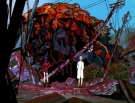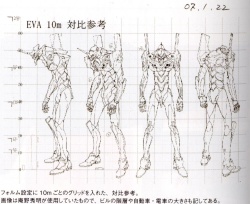Evangelion 1.0 Complete Records Collection

|
"Making something... Nurturing something is really great. You can see and learn so many things from the process." |

|
"When Aoba called B Wing's construction sloppy he hadn't seen anything like THIS!" |

| |
| Title | Evangelion: 1.0 You Are (Not) Alone Complete Records Collection |
|---|---|
| Original Publication Date | May 2008 |
| Publisher | GAINAX, khara |
| Pages | 512 + 298 +234 |
| Dimensions | 32.6 x 23.3 x 8.3 cm/4200g |
The Evangelion 1.0: You Are (Not) Alone Complete Records Collection (ヱヴァンゲリヲン新劇場版:序 全記録全集)(ISBN 978-4-903713-17-5) (ISBN 978-4-905033-01-1)is a massive collection of material related to the first Rebuild movie. It consists of three books packed together in a cardboard box. The first book, hardcover and also in a hard slip cover, contains everything from interviews with staff to concept art and a breakdown of the movie cut by cut. The other two books are the storyboard for the movie split into A and B parts. It was re-released in 2012 with khara/Groundworks as publisher.
Contents
film
A breakdown of the entire movie cut by cut, with dialogue under some shots. From the khara logo all the way to the end trailer and credits. Music cue sheet and additional scenario also in this section.
archives

New logo designs, color palettes for the various characters, new character, Eva and angel designs, 3D models of various vehicles, buildings and other structures, layout pages, monitor display screens and generally a metric ton of stuff.
One of the most interesting parts in this section is that it shows Evangelion Unit 01 on a 10m grid along with a train car and a regular car. This finally gives Evas an official height of 80m from the ground to the top of the pylons, although this is assumed to apply to Rebuild only.
art
Concept paintings of the various scenes from the movie.
interview
Yoshiyuki Sadamoto - Main Character Design, Animation Director (25/07/2007)
Ikuto Yamashita - Main Mechanical Design (28/02/2008)
Shinji Higuchi - Additional Storyboards for New Segments (02/08/2007)
Tomoki Kyouda - Additional Storyboards for New Segments (03/08/2007)
Shunji Suzuki - Lead Animation Director (22/01/2008)
Hidenori Matsubara - Animation Director, Design Works (25/07/2007)
Takeshi Honda - Mechanical Animation Director (25/07/2007)
Shoichi Masuo - Special Effects Director (25/07/2007)
Hiroshi Haraguchi - Production Supervisor (25/07/2007)
Takeshi Takakura - Design Works (25/07/2007)
Tatsuya Tanaka - Key Animator (05/12/2007)
Kazuko Kikuchi - Color Designer (25/07/2007)
Hiroshi Kato - Art Director (25/07/2007)
Daisuke Onitsuka, Hiroyasu Kobayashi - CGI Directors (25/07/2007)
Eiji Inomoto, Ryuta Undou - CGI/VFX (05/11/2007)
Atsuki Satou, Hibiki Watabe - CGI/VFX (05/11/2007)
Tomoko Masuda - 2D Digital Work (05/12/2007)
Susumu Fukushi - Director of Photography (03/08/2007)
Hiroshi Okuda - Editor (07/11/2007)
Shiro Sagisu - Music (13/01/2008)
Tooru Noguchi - Sound Effects (07/11/2007)
Toshimichi Ootsuki - Executive Producer (16/11/2007)
Masayuki - Director (16/11/2007)
Kazuya Tsurumaki - Director (25/07/2007 & 05/12/2007)
Translated by Riki
Kazuya Tsurumaki
He supported the TV series as an assistant director with Masayuki. In the film version of "The End of Evangelion", he created the dynamic Evangelion Mass Production Units and Evangelion Unit-02 action. Kazuya Tsurumaki, who also worked on "FLCL" and "GunBuster2", created edgy and sharp images. In "1.0", the climax of "Operation Yakushima", what is the meaning behind the act of "REBUILD"? And what is the meaning of doing a new Eva?
If I'm going to participate in this project, I want it to make worthwhile.
Interviewer: According to Mr. Sadamoto, when he saw that you, who was the least likely to participate in the project, was taking part, he thought that something really special was going to happen. From your own point of view, what was the reason for your participation?
Tsurumaki: I was misunderstood at first, and ended up "participating" in the project before I understood exactly what was going on. When I first heard about the project, I was called by Anno, and I was thinking, "What, what?" He asked me out of the blue, "What would you like to work on next after GunBuster 2, Evangelion 2 or the new work of a very famous anime?" I was confused, but as I was giving my opinions on this and that, I came to the conclusion that "Eva 2" was the way to go. At that time, Anno's new work was supposed to be a completely different project from "Eva".
Interviewer: Is "Eva 2" something different from the "New Movie" that you're working on now?
Tsurumaki: I had assumed that Anno's next anime would be called "Evangelion 2". Even so, it's not a pure sequel, it's something as different as "First Gundam, Gundam 0079" and "MOBILE SUIT GUNDAM SEED". In short, the anime that Anno-san is going to make will all be titled "Evangelion".For example, a work like "The Gutsy Frog" would be called "The Gutsy Evangelion", and "Star of the Giants" would be called "Baseball Evangelion". It's a kind of branding, like "VAIO" for all Sony computers.
That's what he meant by "2". At that time, there was talk that if I wouldn't do it, he would assign it to someone else. Apparently, Mr. Anno wasn't going to officially direct the film, so it was okay to have a completely outsourced staff.
Interviewer: I see. There has been talk of a "G Evangelion" like the "Mobile Fighter G Gundam" in the Gundam series for a while, hasn't there?
Tsurumaki: Now that I think about it, there must have already been talk of a compilation at that time. But I just assumed that he was talking about "Evangelion 2" and listened to him. I told him, "If you're going to make Eva, you have to do it yourself, and if you're going to do anime again, I'll have to help you."
Interviewer: So there was a twist in the story, and it turned out that Anno's next project was a remake.
Tsurumaki: That's how it ended up (laughs). To be honest, if it hadn't been for the Evangelion remake, I think I would have felt more comfortable participating. That's my honest opinion. However, even if it was Evangelion, as long as Mr. Anno is going to do anime again, I think I should participate in that work, so I had mixed feelings about it.
Interviewer: Is "Eva" such a resistant existence?
Tsurumaki: Of course. I mean, I think, "Of course, everyone is resistant to it."
Interviewer: But as a result, it's not a remake, it's becoming something new called "REBUILD".
Tsurumaki: Yes. This "New Movie" is practically becoming "Evangelion 2". I don't know if Anno originally had this in mind, or if he just came to his senses during the script writing meetings. At first, it was just a compilation.
Interviewer: That's what everyone has been saying.
Tsurumaki: It's been a little over a decade since the TV anime ended, and for new fans who want to watch "Evangelion" now, it would be hard to rent all 26 TV episodes and the movie version at a video rental store. So if you're wondering, "What's the story behind Evangelion?", If you want to know what Evangelion is all about, you can rent it and watch the whole thing in about three to four hours on a holiday. If that's the way "Evangelion" is going to be developed in the future, it's better for business. Besides, it would be relatively easy to make. We were just saying, "Let's make it easy." At first, it was just a compilation.
Interviewer: In reality, though, you've come to a place that's far from easy at all.
Tsurumaki: According to the original plan, after "GunBuster2" was finished last summer, I completed one film every six months, and by the end of this year (2007), the trilogy was completed. It was supposed to be finished in a year and a half. I thought, "Well, that's not too hard, so it's okay." In the original plan, there must have been about a hundred new cuts for the first part, "1.0". The rest would be digitally edited. Even the 14 episodes of the TV series are not really a compilation, although they are a compilation in terms of pictures.
Yoshiyuki Tomino was always good at that kind of thing, and I think Anno made episode 14 based on works like "Uso dancing in a hallucination" (*1) from "Mobile Suit Victory Gundam". It was a compilation, but not a compilation. Anno may have had something similar in mind from the beginning. For me, too, if I'm going to do something, it's worth doing it if it's similar but different. That's why I don't think I had any motivation from the beginning, but rather after I started making it, I found the value in making it.
(*1) You can watch the episode from here, https://www26.gogoanimes.tv/mobile-suit-victory-gundam-episode-45 or https://animeflix.eu.org/mobile-suit-victory-gundam-episode-45
Interviewer: I see. How do you divide up the actual directing work?
Tsurumaki: To put it simply, Masayuki directed the first half of Part A, and I directed the second half Part B. In total, Mr. Anno is looking after the film as the general director.
The reason I thought, "Even if it's a compilation, it's okay," is because I can do Operation Yakushima in the second half. In the TV series, everything after the storyboard for episode 6 was ordered by another company, and Gainax had no control over it. So I had some regrets that I wanted to do something more.
・・・
Interviewer: Shinji Higuchi and Tomoki Kyoda drew the storyboards for the new film, right?
Tsurumaki: The storyboard itself had two parts, one from the TV series and a new part created by the two of them, and I was the one who put it all together in the end. Both Mr. Higuchi and Mr. Kyoda came up with different storyboards from the previous Eva series. We ordered new storyboards, so of course they thought, "There's no point in making it the same as before." I think it turned out to be an interesting storyboard in its own way. But when we got to the stage of putting it together, some people said, " It doesn't feel like Evangelion." So we went back to the old storyboards and checked the DVD, and while remembering the "Evangelion grammar" again, we tried to incorporate their storyboards into the Evangelion. That's what I did for a long time.
Interviewer: Mr. Higuchi was in charge of the storyboard for "Operation Yakushima," but where did Mr. Kyoda work on the storyboard?
Tsurumaki: He is mainly in charge of the storyboards for the new cuts, which are detailed as connections, and the conversations and human drama. Mr. Kyoda's work on "Rahxephon" and "Psalms of Planets Eureka seveN good night, sleep tight, young lovers" may be perceived by the public as being influenced by Evangelion, but when you look at the storyboards, they are quite different from Evangelion. I think it's inevitable, because things may have changed after "Eureka", and I myself have changed over the past ten years. So I decided to remember the grammar.
Interviewer: What exactly is this "grammar" that you speak of?
Tsurumaki: It's difficult to explain, but the easiest way to understand is the way the cuts are connected. For example, the rhythmic insertion of cuts in the flow. You can break up the cuts to make the flow more pleasant, or leave out cuts that should normally be included. There is also the difference in size between close-up and panoramic shots of the characters, and a peculiar stoicism. This stoicism is related to the fact that I dare not move the film. Originally, this was a directing method that I developed in order to distribute resources well so that the schedule and quality of the TV series would not collapse, and it is directly related to cost performance. After that, I went in the opposite direction, moving things around. This was the case with "Kare Kano" and "FLCL" as well. I dared to go back to "Evangelion" again.
I realized once again that if I don't pursue the finely honed sensibility of the images of that time, it won't become Evangelion.
Interviewer: When did you start working on the storyboards?
Tsurumaki: It was from October to the beginning of December last year (2006). Originally, I had planned to make a 90-minute film, but I had already increased the length of the film through storyboarding, and it ended up being almost a hundred and ten minutes long, which is like a massive work. I think I dropped it once more in the rough editing stage.
The original script was tightly written, but at the stage of finalizing the script and storyboarding, we started to say, "Let's include that scene," or "Let's include this scene," and it ended up looking like a collection of famous scenes. I'm trying to trim it down once more.
To put it more fundamentally, is it an event film to entertain the original Evangelion fans, or is it a film to attract new fans? If it's the former, then it's okay if it's a collection of famous scenes, even if it's a broken story. My mind was wavering from day to day as to which it was. One day I'd say, "Fans will be upset if we don't include that scene," but the next day I'd say, "No, no, no, it's just a collection of famous scenes." I spent a lot of time compiling the storyboards while dealing with such conflicts.
When I finally got the film together, I started to get the feeling that I should make it into a movie, so Anno cut it down and made it into a film.
Interviewer: What were some of the difficulties you had in putting the film together?
Tsurumaki: I think making a film means cutting off the branches and leaves and concentrating on the trunk. But since it's originally a TV show, there are many good branches, and those are the ones that I enjoy. In particular, the first six episodes are usually completed in two sets, so there are many branches and leaves attached to the three sets of stories as the trunk. But if you don't remove the branches and leaves, the story doesn't become a movie.
Also, at the screenplay stage, a new branch was introduced: the adult-like conversation between Ritsuko and Misato. I thought it would be a response to the childish side of the story. In the early days of TV, it was still a robot animation. But Evangelion as a whole left a serious impression in the latter half of the series. I think Anno is trying to adjust the balance by adding an adult perspective and bringing in the serious atmosphere of the latter half. However, in order to put it all together in the main body of the story, these are branches and leaves that are not necessary.
Interviewer: Overall, it seems like the fourth episode where Shinji wanders was omitted.
Tsurumaki: That's a scene that was omitted in the initial script, but we were able to bring it back. In particular, Anno-san has been adding a lot of interesting urban scenery to the film, especially with the CGI buildings. In this way, the situation where Shinji wanders around is necessary to show the vastness of the terrain around TOKYO-3, and to give a sense of life through the monorail transportation. So I took it all back, and then cut down the parts that were too much, leaving only the necessary parts.
Interviewer
I also felt that overall, Shinji's feelings were slightly positive.
Tsurumaki: That's a difficult part. In a normal story, the protagonist grows up and ends up winning, but Shinji seems to be positioned as a character who never grows up. However, if you look at the TV series closely, you can see several milestones in Shinji's growth that you wouldn't mind seeing as the final episode. I think that's episode 6 and episode 19. The end of episode 19 goes in a different direction, but if they win against Angel and declare, "This is the last episode!", I think that would have made for a really good robot anime.
When you think about it, it's not that Shinji hasn't grown up. It's just that there's an even tougher development waiting for him, and he repeatedly worries and gets lost. The final "growth" was not portrayed clearly, especially in the last episode of the previous movie, so Shinji was perceived as a very spoiled character.
We haven't decided on the ending for this (1.0) yet, but it seems that there is a plan to make it a happy ending, so I thought it might be better to make it a more straightforward story of growth from the beginning. In the storyboard I submitted to Mr. Anno before the final draft, I had drawn a clear picture of growth. But Mr. Anno changed the nuance a bit. Maybe he thought that was too much.
If you look at "1.0" as a stand-alone movie, I wanted it to be a story about Shinji growing up, winning, and ending on a happy note. I tried to make it look like a normal movie.
Interviewer: I'm sure the audience will be highly satisfied with this movie, including the way it fits together.
Tsurumaki:I think it will definitely be easier to watch. Of course, people who like Shinji as a useless person might be repulsed, but I do think that if it's Shinji up to episode 6 on TV, it's not surprising that this would happen.
Hideaki Anno - Director in Chief (17/12/2007)
advertising
Contains various posters as well as the two trailers broken down cut by cut.
the other
Contains pic of all the other promotional stuff: movie tickets and pamphlets, OST and DVD covers, Doritos packs, UCC coffee cans and other stuff.
scenario
Contains the 42 page script.
(Numbers-kun translates a deleted scene involving Kaworu.)
poster
A foldout poster of Rei drawn up by Sadamoto
